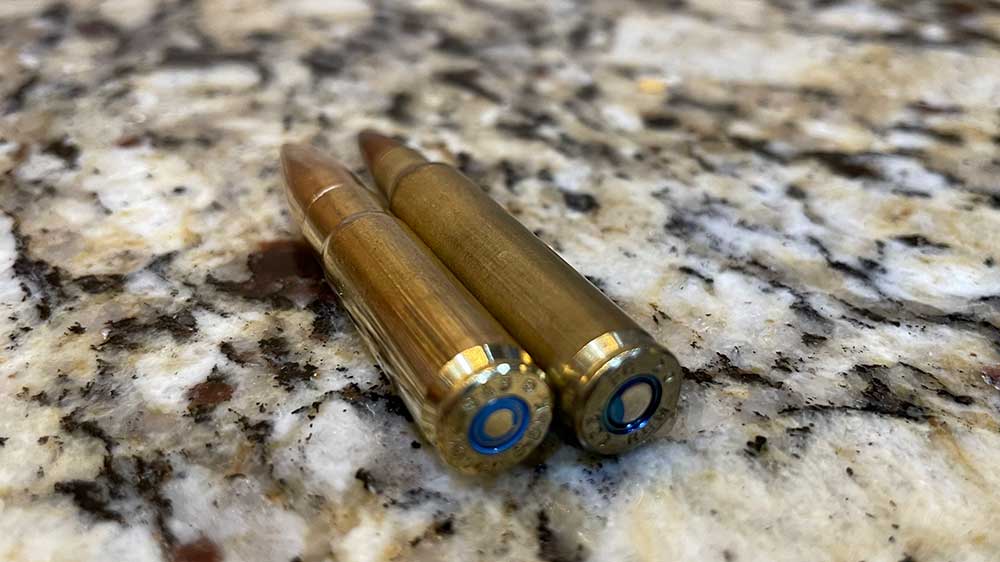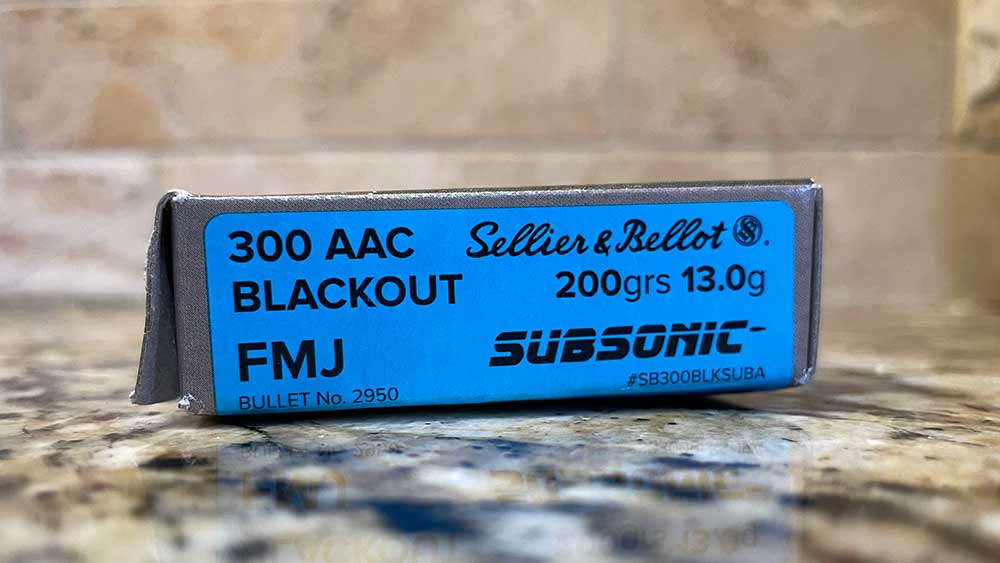Not too long ago, we looked at the difference between .22LR vs. 5.56 (.223) and figured we would continue that journey. Next, we are looking at 5.56 (.223) vs. 300 blackout.
We will analyze a few things with these two rounds and discuss why they are comparable and which one is the best.
Quick Note: Throughout this article, blackout and blkout will be used interchangeably as blkout is often the shorthand form of the full caliber name .300 AAC Blackout.
The end might surprise you, so hang in there!
History of 300 Blackout
The premise of the 300 blackout round was to find a round that would be better in a sub-gun, namely the H&K MP5SD, which is a 9mm submachine gun.
Since the MP5SD was 9mm, the end-users, typically Special Forces, needed the 300 blackout to have more power, similar sound suppression, and be AR15/M4 compatible. Which, if you can’t tell, is a tall order!
The entire premise of the 300 blackout round was to provide a round with better ballistics from a short-barreled rifle. Advanced Armament Company (ACC) wanted to achieve the trifecta. Beat the 5.56m NATO round, achieve better-suppressed sound levels, and rely on the AR-15 platform.

.300 AAC Blackout
The answer that AAC came up with was .300 AAC Blackout. The .300 AAC Blackout is a 7.62 x 35mm rifle cartridge that addresses the issues that are long associated with the 5.56mm round.
At the time, AAC even developed a concept platform for the 300 Blackout round, the Honey Badger. The Honey Badger didn’t come to life until later when Q, LLC created the Honey Badger and Honey Badger SD.
5.56mm NATO
The 5.56mm NATO is the most popular round for the AR-15 and has been used for decades. 5.56mm round dates back to the 1950s, and these bullets replaced the 7.62mm rounds, which were heavy and had stability issues.
Since 5.56mm bullets were small, high velocity, and provided good thermal ballistics, so much so that it became the standard bullet that is still used by much of NATO forces.
Performance and Design
To compare the performance of bullets, we will compare both bullets in all sections that are mentioned below:
- Case
- Power
- Range
- Weight
- Recoil
- Usage
- Availability & Cost
5.56 vs 300 Blackout Case Comparison

The casings for both the 5.56mm NATO and .300 AAC Blackout are almost identical. Both bullets have rimless and bottleneck case types, and both are used in rifles and AR pistols. Both use versions of the .223 Remington casing. The .300 Blackout is a necked-down version of .223/5.56mm.
From the above table, we can see that both cases have the same overall length.
300 Blackout Weight vs 5.56
There are different grain weights available for both the 5.56mm and the .300 AAC Blackout bullet. Some of the most common grain weights for 5.56mm NATO bullets are:
- 55 grain
- 62 grain
- 63 grain
If you look at a .300 BLK bullet itself, you’ll notice the size difference of the bullets immediately.
So obviously, the grain weight for the .300 blkout will be more than the 5.56mm. Some common grain weight you’ll see for 300 blackout is:
- 78 grain
- 110 grain
- 125 grain
5.56 vs 300 Blackout Power and Range
Both 5.56 and 300 blackout have been extensively tested. What testing has found is that 5.56mm at 500 yards had a high-velocity thanks to the lower weight of the 5.56mm NATO bullet. The round can cover more yards and keep velocity better than its heavier counterpart.
In testing fired from a 16″ barrel, it was shown that 300 blackout had nearly double the ft-lbs on the impact that a 5.56 round had 200 yards and 300 yards. The bullet drop becomes much more substantial at range with the .300 blackout round.
On the other hand, where .300 blackout really shines is out of a short barrel. Testing a 9″ barrel with .300 blkout 125 gr round had 993 ft-lbs at 100 yards. The 5.56mm 55 gr round had 191 ft-lbs at the same yardage.
There is a 1,000 feet per second discrepancy in the two rounds, but that’s expected with such a large grain weight difference.
Here’s a small table that compares the ballistic performance of 5.56mm NATO and .300 AAC Blackout in a standard 16″ barrel.
Recoil
Due to the 300 BLK bullet’s larger grain and increased powder, this round’s perceived recoil is stronger than the standard 5.56mm bullet. The 5.56 round has minimal recoil; increasing that recoil only slightly to get the performance the .300 blackout offers is almost not worth mentioning. Still, it had to be mentioned to be thorough.
Availability & Cost
5.56mm is a widely used round and can be purchased from your local gun store or almost any retailer that sells ammo online.
Many ammunition manufacturing companies are doubling down on all rounds, especially 5.56. The 5.56/.223 are cheaper rounds than the .300 blackout, even though before 2020, the .300 blackout cost per round was beginning to drop to reasonable levels (.50-.80¢ per round).
As of this post, Gorilla Ammunition has .300 Blackout in stock!
During “normal times,” 5.56/223 rounds lived in the range of .25¢ – $1 per round, depending on the grain you buy. Seemingly low cost compared to the BLK .300 bullet that costs between .80¢ – $3 per round as of this writing if you can find them.
Gorilla Ammunition has limited 5.56/.223 Ammo in stock as of this post!
5.56 vs 300 Blackout Magazines
One of the other interchangeable parts of the AR-15 is the magazines. You can use any 5.56 magazine for 300 Blackout.
There are 300 Backout specific magazines that are said to have a slightly stiffer spring to assist with feeding but I personally have never had any issue with standard 5.56 magazines.
There are really only two reasons to buy specific magazines for either caliber. Upgraded springs for 300 blackout is one and clearly separating your calibers because you do not want to mix these two calibers.
Some magazines have 300 blackout marketed on them but my personal choice is to use two different sizes. I use 30 round magazines for 5.56 nato and 20 round magazines for 300 blackout.
My personal favorite .300 blackout magazines are the 20 round Lancer Magazines.
Usage of the bullets
The 5.56 round is mainly known for its use in military and police applications. In the last decade, the round has been heavily adopted by gun lovers and sportsmen alike. Many people see the round as a great defense round and use them in their home defense rifles.
The 5.56/.223 round will probably be the mainstay for the AR-15 platform for many years to come, even though the .300 blackout is starting to give it a run for its money.
Special Operations and specialized military units have been testing and using .300 blackout for the better part of the Global War on Terror.
The round serves a particular purpose and is becoming more and more popular in the shooting community. Given the round’s increased cost, it hasn’t yet replaced the 5.56 as the target/plinking round of choice, but many prefer it in self-defense use cases.
It’s worth noting that many people have started to use the 300 blackout round in hunting applications, including bolt rifles, due to their ability to suppress the round well and impressive ballistics.
So as a good friend of mine suggested, building an identical 5.56 rifle and 300 blackout rifle for training/target rifle and the latter for defense would be rather genius and save a substantial amount of coin – long term.
5.56 vs 300 Blackout Terminal Ballistics
To dive further into 5.56 vs. 300 blackout, we have to look at terminal ballistics. Terminal ballistics is the behavior and effects of the projectile when it transfers its energy to the target.
The study of terminal ballistics includes factors such as penetration, fragmentation, and density.
Power (ft-lbs) isn’t everything when it comes to terminal ballistics range; impact and bullet drop are important factors. Even though the 5.56mm bullet diameter is smaller, its speed and fragmentation at the moment of impact make it a favorable candidate for lethal purposes. In some cases, the 5.56mm bullet can pierce through armor, but that needs some extra amplification.
The .300 BLK, on the other hand, is a larger diameter round that is often slower but hits with more ft-lbs on target. The 300 blackout is also a much better round when it comes to suppressing. Let’s talk about super and subsonic ammo.
Supersonic and Subsonic Ammunition

To better understand subsonic and supersonic ammo’s purpose, we must understand what subsonic and supersonic mean when it comes to bullets.
Supersonic is anything capable of achieving a rate greater than that of sound. This means it’s piercing the sound barrier. On the contrary, if speed is less than that of sound, then it is subsonic. The speed of sound is 1,125 feet per second.
Now that you have a basic understanding of supersonic and subsonic, let us talk about 300 blackout and .223 some more.
The 300 blackout round was developed to suppress. So the fact that .300 blackout has tons of subsonic options makes complete sense.
At the ear, shooting suppressed supersonic 300 blackout is nearly the same as 5.56mm. But with a subsonic round, the difference is night and day.
Shooting subsonic .223, while they exist, doesn’t really make sense ballistically. It basically takes your .223/5.56 round and nerfs it down to a .22LR. After all, we covered the major difference between .22LR and .223 before, and the major difference was powder.
Personally, I wouldn’t shoot subsonic ammo without a suppressor, no matter what gun I’m shooting. The increased cost of subsonic rounds doesn’t make sense without a silencer.
The best grain for subsonic speed is often disputed, but generally, the higher the grain weight, the more likely the round is to be subsonic.
What’s the best round 5.56 or 300 blackout?
The best round depends on your usage as we have discussed, the cost is a major factor. If you buy a gun for home defense and security, either caliber is a good choice to keep your family safe.
Shorter barrels are generally better for close quarters, so if that’s your plan, give 300 blackout a hard look. If you plan to suppress and you want to be the quietest you can be, 300 blackout is your go-to. But if you want cost-effective range fun that allows you to train more than once or twice a year, you might want to stick with 5.56/223.
Conclusion
In this article, we discussed the two most popular rounds for the AR-15 platform of rifles. We saw how both bullets are similar but also very different in application.
We highlighted their respective usage and what’s the best-case scenario that the rounds can be used. In our opinion, choosing the round comes down to personal choice and application. You can only decide what your application is and what best works for you since many great ammo manufacturers make high-quality factory ammo for both.
It helps that great barrel manufacturers like Ballistic Advantage, Noveske, and Q are making top-tier barrels for both calibers and many are making dedicated 300 Blackout Guns.
If you want to check out our other ammo made for the AR-15 platform, check out 458 SOCOM and all our ammo articles. Want to learn a little more about rifle cartridges? Check out two of the most popular bolt gun rounds available today the 6.5 Creedmoor vs .308 Winchester.











































